The Tajik Civil War (5 May 1992-27 June 1997) was a civil war between the government of Tajikistan led by President Emomali Rahmon and supported by Russia and Uzbekistan, and the Islamist United Tajik Opposition, which was supported by the Taliban, Northern Alliance, and Jamiat-e-Islami from Afghanistan. During the conflict, 15,000 Russian Army troops were deployed to assist the Tajik government in putting down the Islamist uprising in the north and east of the country. The war ended on 27 June 1997 with a compromise that gave the opposition 30% of ministerial seats, but from 19 September 2010 to August 2012, there was a renewed insurgency by the UTO and the Islamic Movement of Uzbekistan. This second insurgency was subdued by the government, ending the fallout of the first civil war. The Tajik Civil War's first phase left 100,000 dead and 1,200,000 displaced, while the second phase left 104 soldiers and over 55 jihadists dead in a much smaller rebellion.
Background[]
The Russian Empire subdued Central Asia during the course of the 19th century and incorporated the lands, including Tajikistan, into their empire. The Russians forced the Tajik people to speak Russian, and Russianized their names, assimilating many of the Tajiks into their culture. However, many Tajiks remained Muslim and refused to convert to Russian Orthodox Christianity, and also maintained their own culture and traditions. When the Soviet Union seized power in 1918-1922, Tajikistan was made the Tajikistan SSR, a Soviet socialist republic that was a part of the union of Soviet republics. Tajikistan, unlike its neighbors, was one of the last countries to secede from the Soviet Union. It was not one of the countries to declare independence in the Fall of Communism in 1989, and it only became independent on 9 September 1991 after the collapse of the USSR.
Like many of the other newly-independent former Soviet states, Tajikistan faced issues regarding its constitution. The Tajik language was promoted after the fall of the Soviet Union, replacing Russian as a major language. Ethnic Russians no longer held a majority in politics, and Russians and Jews fled Tajikistan to avoid persecution and poverty, hoping for better economic opportunities in the West or in other post-Soviet countries, including mother Russia itself.
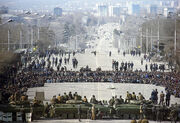
Riots in Dushanbe in February 1990
Relating to the ethnic crisis, under-represented ethnic and regional groups from Gharm in the north and Gorno-Badakhshan in the east of the country protested against former Tajik Communist Party General-Secretary Rahmon Nabiyev's acession to the title of President of Tajikistan. In 1985 he had been ousted in a corruption scandal, but on 2 December 1991 he regained power after a seven-day term from 31 August to 6 October. Disputes concerning the election led to street riots against Nabiyev, and the Tajik Democratic Party, Islamic Renaissance Party, democratic reformists, and other opposition groups formed the United Tajik Opposition to rebel against Nabiyev's rule.
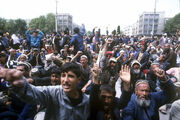
Riots in Shakhidon Square in 1992
The United Tajik Opposition initially partook in riots against the regime, but soon, the democratic liberals and Islamists rose in rebellion against the elite of the country, who had been in power since the days of the USSR. On 7 September 1992, Nabiyev was captured by the opposition and forced to resign his presidency at gunpoint. Chaos between the factions raged outside the capital of Dushanbe, starting the civil war.
War[]
Tajik Civil War[]
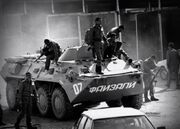
Russian Spetsnaz troops in Tajikistan
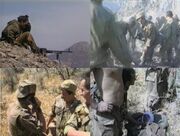
Collage of Russian troops in Tajikistan
In December 1992, Emomali Rahmon was elected by the former ruling faction as the new President of Tajikistan, and gained the support of Russia and Uzbekistan. From 1992 to 1993, Kulyabi militias loyal to Rahmon and the government fought the UTO and Pamiris from Gorno-Badakhshan. 15,000 Russian troops were deployed to Tajikistan to assist in the crushing of the rebellion, which was near to a revolution. The government ethnically cleansed Pamiris and Garmis, expelling them to Afghanistan or killing them. In the areas south of Dushanbe, many prominent individuals were murdered and mass killings and burning of villages occurred, inflicted by the government upon the rebel groups.
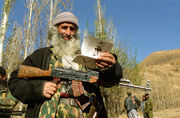
An old fighter of the United Tajik Opposition with an AK-47 and a medical handbook.
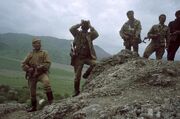
Tajik troops patrolling the border with Afghanistan
The war degenerated into a stalemate, with fighting concentrating in the south of the country and around and in Dushanbe. Islamic radicals from Afghanistan, of both the rival Taliban and Northern Alliance groups, joined in the battle. The Afghan Islamists, who were also fighting the Afghan Civil War in their home country, contributed several fighters to the rebel cause, and the war devolved into stalemate as the two sides fought several battles in southern Tajikistan and around Dushanbe. Russian troops battled the Tajik rebels in a war that left anywhere between 50,000 to 100,000 people dead and 1,200,000 homeless in and out of Tajikistan, in a war that is nearly forgotten by the world.
On 27 June 1997, the United Nations brokered a peace treaty between the government and the rebels. The treaty allowed the United Tajik Opposition to have 30% of ministerial positions, although in 1999 Rahmon won the elections to have another term as President of Tajikistan. The United Tajik Opposition's Tajik Democratic Party and the Islamic Renaissance Party, which were banned, were restored to legitimacy as a part of the treaty.
Intermission[]
Between 1997 and 2010, sporadic violence continued. Intellectuals fled Tajikistan in a brain drain, and dozens of Tajik journalists were killed. On 9 June 1998, Bukkharan-Jewish journalist Meirkhaim Gavrielov was strangled by a metal wire; the government initially claimed that he committed suicide, and the perpetrators of his death are still at large. On 22 September 1998, Tajik politician Otakhon Latifi was assassinated by Ravshan Gafurov, who later confessed to the murder and was killed trying to escape from police custody. The corrupt autocratic government of Rahmon continued to rule for decades without much opposition.
Insurgency in Eastern Tajikistan[]

A Tajik army checkpoint in the Rasht Valley, September 2010
On 19 September 2010, violence flared up again as 25 Tajik soldiers were killed as their 75-man convoy moved through the Rasht Valley searching for members of the Islamic Movement of Uzbekistan that had escaped from detention on 25 August. On 4 October, 5 Tajik troops were killed in a gunfight with two IMU insurgents that were stopped by some soldiers, but the two insurgents were also killed.
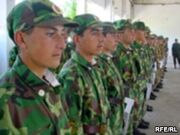
Tajik troops in 2010
The Tajik government responded to these attacks by conducting operations in the Rasht Valley, the stronghold of the IMU and UTO. The costly war led to many parents sending their sons out of the country to avoid the summer drafting of soldiers to fight the rebels, but in 2011 many rebel leaders were killed by the Army. On 25 July, an operation by 800 Tajik troops led to the capture of rebel commander Tolib Ayombekov, which ended the fighting by August. Over 159 people (104 Tajik troops and 55+ insurgents) were killed in the second phase of the civil war, which defeated the opposition forces.
